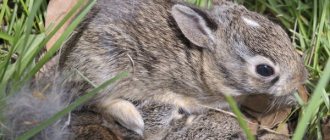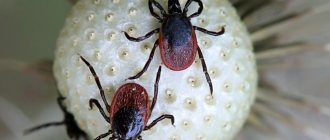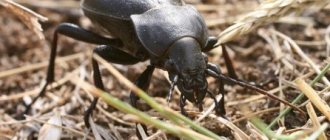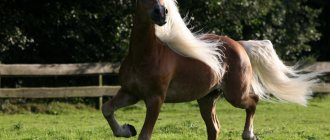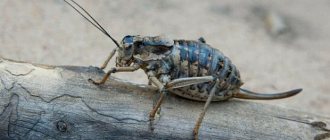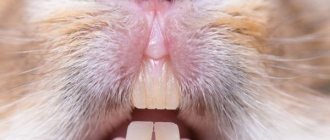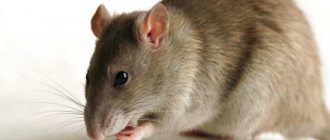Most pet rodent owners are concerned about the proper development of their rat pups. In this article, we will take a detailed look at the stages of development of baby rats, the rules for caring for them, and when they are ready to start interacting with their owners. We will also learn how newborn rats behave and learn how to properly care for them.
In addition, we will answer common questions from owners, such as “when do newborn rodents open their eyes?” and “what should I feed them?” And most importantly, we will learn what needs to be done to ensure that the baby grows up to be a healthy and happy rat.
Preparing and feeding newborn rat pups
Sometimes it happens that a rat dies after a difficult birth or refuses to feed its offspring with breast milk. Then the owner must come to the aid of the cubs. Self-feeding baby rats in the first days of life is a rather tedious and time-consuming process, so you will need to be patient. Babies need to be fed in a strictly established sequence:
- First, you need to take each rat in your hands one by one and massage the lower abdomen with a cotton pad soaked in warm water. This is necessary so that the kids go to the toilet in a small and large way. Feces should be removed immediately using a regular napkin.
- Next, you will need to fill the syringe with warm goat milk (preferably homemade) and put a subclavian catheter on it, cut to 1-1.5 cm. The fattier the liquid, the more willing the baby will be to eat.
- The cut end of the tube is inserted into the rat's mouth 2-3 mm. Then you need to carefully, as slowly as possible, press the plunger. For the first time, the baby will spit out milk and slurp, then it will get used to it. Over time, babies will eat more and more actively, so you will need to restrain them a little so as not to choke.
From the second day, regular baby formula labeled “1” can be gradually diluted in goat’s milk. The amount of dry powder should be 2 times more than indicated in the preparation instructions on the back of the package.
When the offspring's eyes open, instead of baby formula, you can mix porridge into goat's milk, which is allowed for children from 4 months of age. Most of all, baby rats like the taste of buckwheat with the addition of dried fruits.
Immediately before feeding, it is recommended to drop a drop of warm milk into each rat's mouth. This will prepare babies for eating and will also prevent them from swallowing the formula too greedily.
Rats are social animals. Adult females have a well-developed maternal instinct. Therefore, it makes sense to look for a wet nurse for the babies. Still, rat milk is much healthier for babies than any formula, even the highest quality one. If you know of a rat whose pups have just died, you can take it into your home. She will happily feed newborns.
You can, on the contrary, take your babies for temporary residence with a nursing female. In this case, before moving in the brood, you will need to temporarily remove the mother rat from the cage and rub the “new” pups with sawdust. Then the female will accept them as part of her own brood and begin to actively feed them. Rats have well-developed lactation, so there is enough milk for everyone.
Diet of baby rats from 1 month
After reaching the age of one month, the rat pups can be gradually offered adult food. New dishes should be introduced carefully, gradually increasing the dose. By the age of 5 weeks, formula feeding is completely replaced by a complete rat diet. For normal growth and development, rat pups will need a balanced and natural diet.
Hard food
Grain forms the basis of the diet for all rodents. Cereals are necessary to maintain the energy and vitality of the animal. It is recommended to offer young rat pups:
You can collect the grain mixture yourself or buy ready-made specialized food at a pet store. When using a purchased product, you need to pay attention to its quality. When feeding young animals, it is better to give preference to premium and super-premium grain feeds.
Juicy food
Juicy feed is an irreplaceable source of vitamins, minerals and fiber, which have a beneficial effect on the organs of the digestive system. Upon reaching the age of one month, rat pups should be gradually offered:
- vegetables - pumpkin, broccoli, carrots, zucchini;
- fruits - apples, pears, avocados, bananas;
- berries - raspberries, strawberries, currants;
- greens - parsley, celery, lettuce, dill;
- grass - dandelion, plantain, nettle.
Plant foods are very beneficial for the body of rodents. However, some succulent foods can cause gas formation, bloating, and diarrhea in young animals.
To avoid unpleasant surprises, it is recommended to introduce fruits, berries and vegetables into the diet of fluffies in the form of purees. You can buy baby food or prepare the dish yourself. If no negative reactions are observed after 3-4 days, fresh succulent food can be given.
Food of animal origin
Animal food is rich in protein, vital for a growing body. Therefore, it is imperative to introduce more meat and fermented milk dishes into the menu of rats. The following products will be useful for baby rats:
- cottage cheese;
- kefir;
- fermented baked milk;
- curdled milk;
- lean meat - beef, chicken, turkey;
- fish;
- seafood - shrimp, crabs, squid.
Animal food is quite heavy for a rat's stomach. Therefore, when compiling a menu for baby rats, it is necessary to focus on the fat content of the products - the lower it is, the better for the kids.
It is recommended to give the younger generation a drop of fish oil 1-2 times a week. This will increase the babies’ immunity, strengthen their musculoskeletal system, and the pups’ fur will shimmer pleasantly under the sun’s rays.
Treats
In addition to the main food, it is recommended to periodically pamper the rat pups with treats. For example:
- dried grasshoppers or worms;
- grain cookies;
- biscuits with carrots;
- nuts and seeds;
- herbal pads;
- crushed peas.
You can buy the listed treats at a pet store, and if you wish, you can prepare them yourself. You should also periodically leave apple, birch and willow branches in the cage with the pups. Such treats not only taste good, but also help to wear down actively growing teeth.
Setting up a house for a rodent
Aquariums are not suitable for this animal due to poor ventilation, and cages for hamsters are not suitable due to their small area. A cage for a pet rat should be special. This is, rather, a two-, or better yet, a three-story house, a kind of cottage with many different exercise equipment.
In addition to its impressive size, a house for a rat must meet the following requirements:
- the cage must be made of durable metal rods, which are spaced at a distance of 10 mm;
- a deep tray is required;
- all exercise equipment should be securely fastened;
- it is necessary to install a drinking bowl with clean water in the house; as a filler it is better to use paper without printing ink, sawdust, wood shavings (layer thickness - at least 5 cm);
- you need a shelter - a secluded place where your pet can rest, hiding from the direct rays of the sun; a children's plastic bucket or clay pot is suitable for arranging such a nest;
- You should clean the cage at least once a week - change the filler completely, clean the tray without using household chemicals with a strong aroma.
Features of feeding rat pups
To avoid adverse consequences during or after feeding rat pups, you need to remember the important features of feeding animals. You need to feed small rodents taking into account the following recommendations:
- During one feeding, a newborn baby eats up to 0.3 ml of milk. From the fifth day of life, the volume of food increases to 0.5 ml. From the 10th day, the amount of the mixture increases by another 2 times. You shouldn’t rely solely on the baby rat’s appetite - a wide longitudinal white stripe on its transparent tummy will tell you that the baby is full. This shows the stomach filled with milk.
- If a baby rat chokes on milk, you need to forcefully pinch its nose so that it rests. He should sneeze until all the milk flies out of the nasal passages. If the technique does not help, you can move on to pinching the back of the body. It's more painful, but more effective. The main thing is to prevent the baby from suffocating.
- During greedy sucking of the mixture, air is often swallowed. This leads to bloating and severe pain. In such a situation, you need to stop feeding and give the baby 0.02-0.03 ml of any drug containing simethicone using a catheter. For example, Bobotik or Espumisan.
- Upon reaching the age of 7 days, you need to carefully examine the gums of the baby rats for the appearance of a whitish coating - a sure sign of thrush. If a problem appears, it is necessary to treat the oral cavity with children's antifungal drugs - Candida, Nystatin, Fluconazole. To prevent thrush, from the first days of life it is recommended to give the cubs a drop of Biovestin, a liquid probiotic.
What not to give
Often, owners of baby rats try to pamper the younger generation with something tasty. However, most delicacies from the human table are dangerous for rodents, especially for babies. The following are strictly prohibited:
- sugar and sweets - candies, milk chocolate, baked goods, ice cream, condensed milk;
- fatty meat, lard;
- semi-finished products - dumplings, dumplings, cutlets;
- sausages, sausages, smoked meats;
- fast food;
- dried, smoked, dried fish;
- fresh milk;
- mushrooms;
- radishes, beans, turnips, rhubarb;
- carbonated drinks.
You also need to carefully monitor the baby rats so that they do not eat forbidden foods. Some plants, for example, can be deadly for rats - aloe, lily of the valley, dieffenbachia, geranium, carnation, lupine, tulip.
A new addition to a rat family is a very important and responsible event. Knowing what to feed baby rats and how to care for them, even a novice breeder can raise healthy and active offspring without any problems.
Source
Rat after birth
It is better not to touch a tired rat at all for some time. Even if you are her best friend and have an excellent relationship, the rat will not appreciate such attention after giving birth and will protect the offspring and its territory.
Make sure that mommy has constant access to clean water. After giving birth, the animal will be thirsty. And if there is not enough fluid, the rat may begin to eat its cubs.
It is strictly forbidden to pick up rats! Your smell will remain on the babies' skin, and after that the mother will stop feeding them. But if it just so happens that the rat refuses to feed its offspring, you can try to feed the pups yourself. To do this, you need to purchase special food or milk replacer for animals. We recommend that you learn the composition of the mixture and feeding technique from the breeders.
Birth
At the second stage of being in an interesting position, it is not recommended to disturb the female, namely:
- move the cell;
- pick up and so on.
This leads to termination of pregnancy.
In the process of bearing offspring, the female needs rest and a balanced diet.
The total gestation time of a rat is 23 days. By the time it ends, a number of hormonal changes are completed in the animal’s body. As for the external features of hormonal changes, they look like this:
- The female becomes somewhat nervous at the sound of someone else's baby squeaking.
- The creation of a nest for delivery is carried out by the animal independently a couple of hours before the start of the process.
- An interesting thing is that if during this period you place someone else’s baby next to the female, the expectant mother will accept him with great pleasure, despite the fact that she has not yet produced milk.
- During this period, the animal’s hostility towards any other animals increases significantly.
The female needs rest during delivery. Fear leads to spasms of the uterus and can provoke the death of an adult. Pathologies during delivery occur due to the non-standard position of the fetus. Often, the death of a female in the prepartum position occurs due to the decomposition of the non-surviving fetus or during pregnancy outside the uterus.
The traditional duration of birth for a rat is 2-3 hours. Before delivery, bloody fluid is released from the female’s perineum, after which the animal feels a contraction. The body is stretched and the sides are stretched to the limit.
Before the immediate appearance of the rat pups, the female sits down and assists their exit using her paws and teeth. The animal also pulls out the birth sac on its own, and then proceeds to the pups: licks them and gnaws the umbilical cord of each one. Experts note that after birth, the animals eat the placenta and umbilical cord. During the birth process, the baby begins to move and make sounds; these kinds of signals show the female that he is viable, and she cannot eat him.
About baby rats
Little rats are almost weightless, they weigh only 4-6 grams. They are born bald and cannot see or hear anything. All that is available to them is to crawl a little and, of course, eat in order to gain strength and grow faster.
The first thing through which the world opens up to them is hearing. On the third or fourth day, the pups begin to hear, by the 6th day they have fur, by the 10th day their teeth erupt, and after two weeks our babies will be able to look at the world around them.
You can determine the sex of young rats no earlier than 14-18 days. At this time, they become even more covered with delicate fur, try to eat on their own, and also learn to get along with their relatives in the same territory.
You can transfer young animals to adult food no earlier than from the 20th day.
Differences between old individuals
After six months, difficulties arise in determining the age of the animal during the weighing process. To do this, you need to take into account various external characteristics. You should pay attention to the length of the animal’s tail. If it is equal to the length of the body, then the animal is definitely more than a year old.
In addition, the following signs indicate maturity:
- Dull and sparse fur, sticking out in some places.
- Rough skin on the tail with a large number of keratinized flaking areas.
- A hunched body, indicating the absence of a fatty layer on the back, which is always present in young individuals.
- Long incisors with ground back.
Content nuances
As soon as the pets are three weeks old, you can pick up the babies. The more you accustom them to your hands, the more affectionate and obedient they will be. The main thing here is not to overdo it. Measure is good in everything. Excessive squeezing can cause stress to the animal.
For a month, mother and babies should not be placed in different cages. Their immunity depends on how long children stay with their mother.
Like dogs, rats grow up to about a year old. When they are a month old, you can introduce cottage cheese, boiled chicken bones, apples, milk corn, and bananas into the babies’ diet. But it is better not to offer yolks, broccoli, lettuce, cucumbers, liver, tomatoes to young offspring.
Follow these recommendations until approximately three months of age.
Rats are very unpretentious animals and caring for a rat family is not at all difficult, the main thing is not to touch anyone with your hands in the first month, and then have time to seat the animals until the new generation brings you new offspring.
Source
Unique Fertility
In the Russian Federation the following types are most often found:
- Gray or pasyuk;
- Black;
- Turkestan (red).
Pasyuk Black rat Turkestan rat
One can only wonder why nature awarded rats with such amazingly productive fertility. They live and breed all over the world, not paying attention to either cold or hot climates, and their activity lasts all round. And only unforeseen natural disasters or any mass diseases can temporarily reduce their numbers.
Scientists believe that it was humans who contributed to changes in the behavior and survival of rats. Living next to a person, eating the products that he produces, these rodents live freely and comfortably. After all, food is always available, and all the traps prepared by people can be avoided. And if one rat was poisoned, the others will no longer approach such food. These animals have a fairly high intelligence. It is assumed that they have the makings of abstract thinking, which helps them navigate and stay alive in an unfamiliar place. All these skills are adopted by subsequent generations.
And considering how rats reproduce, all that remains is to start fighting them in time, because their activity in this case can take on catastrophic proportions.
Newborn rat pups: development, care and feeding of baby rats
Newborn rat pups are a cute and sometimes shocking surprise for the rodent owner. Beginning rat breeders sometimes encounter the problem of unexpected pregnancy in their decorative rat; this happens after going with their pet to visit relatives, accidentally keeping rodents of different sexes together, or covering a female with a wild male; sometimes pregnant rats are already sold in pet stores.
An inexperienced owner of a pet rat may not even be aware of the imminent replenishment of his pet’s family, in which case the discovery of a whole brood of naked squeaking lumps in his pet’s cage may come as a complete surprise to him. Sometimes, owners purposefully breed a female rat to produce rat offspring at home.
Possible problems during pregnancy
The owner of the rodent needs to closely monitor its condition. In most cases, pregnancy proceeds normally, but sometimes complications occur. Health problems can be caused by stress.
Situations in which urgent veterinary care is needed:
- the rat is lethargic, does not eat anything;
- pus or blood is released from the genital loop;
- the baby rats do not move in the stomach - this can be detected at the end of pregnancy;
- labor lasts more than 5 hours.
What do newborn rat pups look like?
Newborn rats, of course, cause affection and a surge of tenderness, but now all worries about the nursing mother and her children fall on the shoulders of the rodent owner.
The baby rat looks very cute and touching, resembling a pink celluloid baby doll with pink skin and a large round head. Little rat pups are completely hairless and are born blind and deaf, although the sense of smell and instincts in these touching babies are already developed. By smell, the cubs find their mother's nipple, gorge themselves on nutritious milk and fall asleep near the warm belly of the female.
How a rat takes care of its pups
Rodents by their nature are excellent mothers; a rat spends the entire day with its pups, tenderly caring for, feeding and caring for the babies. The female covers her large brood with her body all day, warming and protecting the cubs. The warmth of the rat's body and frequent feeding with nutritious milk stimulate the development of all organ systems of small animals; it is almost impossible to feed and keep newborn babies alive without the care of the mother.
Sometimes a rat produces a litter of 15-20 pups
, some of the stronger cubs more often than others end up near the nipple with milk, the rest of the pups may die without feeding. In such cases, in the second week, you can place briefly fed nimble babies in a separate container, maintaining a constant temperature of 39C in it; for this purpose, you can use a heating pad or bottles of warm water.
At birth, baby rats cannot empty their bowels on their own; the mother often licks the babies' bellies, stimulating bowel function and removing newborn feces.
A small rat is a completely hairless creature; the body of a tiny animal becomes overgrown with fur only in the second week of the rodent’s life. Decorative rat cubs are not able to maintain a constant body temperature, so naked babies physically cannot survive without the warm belly of their mother.
If the mother leaves the newborns for a few minutes, the body temperature of the pups instantly drops, they stop moving and fall asleep. The mother carefully monitors the body temperature of each baby all day, and if necessary, the rat changes places between the children.
The rat gradually reduces the time spent near children, adapting newborns to environmental conditions and independently maintaining normal body temperature. If at birth the female practically does not leave a brood, then by the end of the first week the babies spend a third of their time without their mother, with a further increase in their independent period.
Bathing
Despite the widespread belief that pet rats love water, they are far from fond of bathing. Water procedures can be complicated by the animal’s pronounced resistance, but some pets are tolerant of this procedure - it all depends on individual characteristics. You need to bathe an animal in the following cases:
- if the wool has an unpleasant odor;
- if the rodent is unwilling or unable to care for itself;
- when infected with parasites.
Development of baby rats by day
Newborn rodents grow very quickly, a defenseless blind lump becomes an adult after 4 weeks, males reach sexual maturity at 5, and females at 6 weeks. The development of rat pups day by day is as follows:
1st day
Immediately after birth, the pups are naked, pink, blind and deaf babies with underdeveloped limbs and a small tail, who can only squeak, suck and sleep.
3-4th day
The cubs' ears open, and now the pups can distinguish not only smells, but also sounds.
5-6th day
The bodies of newborns begin to be covered with the first soft hair, the skin has become flesh-colored with dark spots, the presence of which determines the color of rodents.
8-10th day
The baby rats are erupting their first teeth, the babies are already covered with short velor fur, the cubs are becoming very nimble, they start fights over the mother’s nipple, their movements are not yet fully coordinated.
12-13th day
The babies' eyes open, the pups explore the territory, actively try to get out of the nest, but the rat diligently returns the children to their original place.
14-16th day
At this time, secondary sexual characteristics are formed and the sex of the animals can be determined; in females, nipples are visible on the abdomen.
16-18th day
Babies actively begin to taste their mother’s food, try to gnaw all surrounding objects, from this period the first complementary foods of animals can be introduced.
20-27th day
The cubs are practically independent individuals, feed on the food of adult animals, milk production declines, and lactation stops by the 27th day of the babies’ life. A physiological feature of rat pups is that during this period they eat the female’s feces and become accustomed to the mineral composition of the adult diet. The rat stops dragging newborns and takes care of the offspring less and less, teaching children to be independent. The babies are still attached to their mother; it is not recommended to separate them during this period.
28-30th day
The pups are already adults, they are curious about everything new, the kids begin to recognize people and play with their owners. In the wild, at the age of one month, rodents already become independent hunters, and provide their own food and housing.
When baby rats open their eyes
Little rat pups are born completely blind and deaf; for the first 12 days of life, the cubs are guided only by smell. Later, in adult life, the rat uses its sense of smell to explore the entire environment. Scientists have proven that episodic memory in rats is structured like that of humans; the animal is capable of not only capturing and distinguishing different notes of odors, but also of associating situations of their occurrence and manifestation. The first aromas that a newborn smells are the smell of milk and the body of its mother.
The eyes of rat pups open on the 12-13th day of life, the babies begin not only to smell, but also to see the world around them.
From the moment their eyes open and they gain the ability to see the world around them, rat cubs begin to actively leave the nest and explore new territories. Rats' eyes are located on the sides of their heads; this anatomical feature gives them a wide viewing angle. The animal, without turning its head, can look with both eyes in different directions, even up, back and down. In this way, nature protects wild rats from attacks by predatory animals and birds.
Productive offspring all year round
Rats' minks are always clean and well-groomed. Having found shelter, they make additional passages and then deftly navigate through them. They find refuge for themselves:
- Digging a hole yourself;
- Having captured a hole already made by another small animal;
- By occupying a nest made by a bird or animal;
- Using any convenient building structures.
They live not only in families, there are also loners. Rats united in colonies pose a particular danger to people, since this form of organization can exceed the number of more than 1000 individuals. Of course, they also need a very large territory. In addition, they guard it very actively. Colonies are found primarily in large cities. Sometimes their number is equal to the population!
If you study the birth statistics of rats, you may get the impression that they are only busy reproducing. With the exception of northern populations, these animals reproduce throughout the year, but the number of pups born varies for each individual. For example, if this:
- The gray rat, on average, can give birth to up to 9 cubs in one litter, but sometimes their number reaches 20;
- The Australian species is distinguished by a smaller number of births - from 3 to 15;
- The Malayan species produces from 3 to 6 cubs in one litter.
However, rats also have enemies who happily eat them, helping people reduce the spread of dangerous rodents.
Caring for newborn rat pups
A rat cub is a defenseless, touching creature that requires increased care from its mother and owner. The mother will take care of the feeding and hygiene of the babies; the owner needs to properly care for the female and her offspring, without interfering with physiological processes. To do this, it is advisable to create comfortable conditions for newborn rat pups:
- In no case should you pick up or examine the cubs; the female may abandon or eat the brood from stress;
- the cage with the rat litter should be in the quietest, warmest and driest room;
- The rat cleans the nest on its own, throwing dirty pieces of bedding into the corner of the cage; the owner constantly needs to give the female clean napkins. You can remove used napkins from the cage no earlier than the 8th day of life, without touching the nest. If the rat becomes agitated when cleaning, put it down;
- watch the cage door, the cubs after the 8th day are very nimble and can jump out and crash on the floor, or the female will drag the newborns to any quiet corner of the apartment;
- feed the female with nutritious food and keep the drinking bowl filled with clean drinking water;
- Carefully introduce healthy complementary foods to babies for the proper development of the digestive system of newborns.
When can you pick up baby rats?
Touching baby rats immediately after birth is highly discouraged! The mother can eat a baby with a human smell, and there is also a chance of accidentally damaging the newborn’s thin bones.
Towards the end of the second week of life, you can briefly remove the newborns from the nest in the absence of the female, examine the pups and determine the sex of the animals. It is advisable to do this while wearing medical gloves or thoroughly washed hands so that the female does not abandon the brood.
From the end of the second week, you can take the babies out of the cage, often in the presence of the mother, so that the rat trusts you and does not worry about the children. Rats at this age are unusually nimble and inquisitive, while the female is on a walk every day, it is advisable to accustom the rats to friendly human communication: carefully carry in two palms, stroke, talk in a gentle voice, wear in the sleeve and in the bosom. Wary tiny animals quickly get used to people and begin to trust them.
IMPORTANT. Lack of active close communication with a person at a young age can make a pet fearful or aggressive towards humans.
Types of breeding
In domestic rats, two types of crossbreeding are possible: selection of different breeds and purebred breeding.
In turn, purebred crossing is divided into the following types:
- Linear crossing;
- Inbreeding;
- Outcrossing;
- Outbreeding.
Linebreeding
Linebreeding or line breeding of rats involves crossing individuals that have a common ancestor. This method allows you to obtain viable offspring with a good genotype. In this case, homozygosity is preserved, and characteristics that do not satisfy the breeder are leveled out.
Inbreeding
To consolidate important breed qualities, the inbreeding method is chosen. Breeding rats in this way involves studying the gene pool and selecting quality sires among close relatives. With close inbreeding, a decrease in the number of viable offspring is possible - so-called inbreeding depression. To reduce the risk of such a situation, individuals for breeding are selected according to strict criteria.
Outcrossing
Outcrossing is used when it is necessary to increase the number of litters with valuable qualities. Mating uses individuals obtained by linebreeding, but without common ancestors in the fourth or fifth generation. To improve the breed, young animals that are unsuitable for a good genetic line are removed from the litter.
Outbreeding
To improve the quality of the breed and the health of the litter, outbreeding is the best option. With such crossing, individuals of a pure breed are selected, but without common ancestors. The disadvantage of this method of breeding is that there is a risk of unplanned characteristics and with frequent use, after several generations the proportions of the animal change.
Despite the different selection options that can be combined, there is still an unpredictable result. This is manifested in the color and length of the coat, the number of individuals in one litter, eye color, and level of health.
When can you give away baby rats?
From 2 weeks of age, it is advisable to frequently pick up babies and give them treats from your hands.
, the animals will get used to doing without their mother and will remember the smell and voice of the owner. While feeding, the baby rat may bite its owner, mistaking its finger for a treat. It is absolutely forbidden to raise your voice in such cases and scare the baby.
At 5 weeks, males must be separated from their mother in a separate cage to avoid uncontrolled mating: an adult female can become pregnant, and from 6 weeks, young females can become pregnant. If possible, it is useful to keep boys with their father and girls with their mother; the cubs learn the life skills they need from adults. In the wild, rats also live in same-sex packs. Babies can be kept near a female or male for any length of time, taking into account the size of the cage and the number of pets.
After jigging, the young animals can be completely transferred to adult food, adding greens, vegetables, fruits and fish oil. At first, it is useful to feed babies with cow's or goat's milk from a pipette.
At 5-6 weeks of age, you can give away rat pups; it is highly not recommended to do this before 4 weeks of age; the cubs during this period are still breastfed; early weaning can negatively affect the health of the rat pup. A late change of owner is also undesirable; adult individuals get used to the owner and experience stress when the environment changes.
Who is better to have: a boy or a girl?
All decorative rats are sociable, unpretentious, smart and easy to train.
When choosing a pet, you should take into account its character and the temperament of the owner. Most boys are phlegmatic, most of the time they rest in their house, hammock or in the arms of their owner. They sleep much more often than girls, eat more, and move less.
From 6–8 months, boys experience hormonal changes. This is manifested by bursts of unreasonable aggression towards relatives and the owner. You need to be prepared for this. In addition, males mark territory and people for whom they feel sympathy. Their urine has an unpleasant, pungent odor that is difficult to get rid of. For this reason, their cage has to be cleaned more often than the females’ home.
Rat girls are more active and restless. They bite owners more often than boys. Pregnant or recently given birth females who protect their offspring are especially aggressive.
Female rats also mark their territory, but much less often than male rats. In addition, their urine does not have such a strong odor.
Rats of both sexes are more active at night and sleep during the day. Therefore, the owner must accustom them to their schedule: games in the evening, sleep at night.
Interesting! The activity of female rats depends on hormonal levels. They are almost constantly in heat; their estrus occurs at intervals of 5–10 days and lasts 14–24 hours.
Males get along better with other pets than females.
Experienced breeders strongly recommend keeping rats in groups (from 2 individuals). They need communication with their relatives for a full life and good health. Solitary confinement does not suit them.
